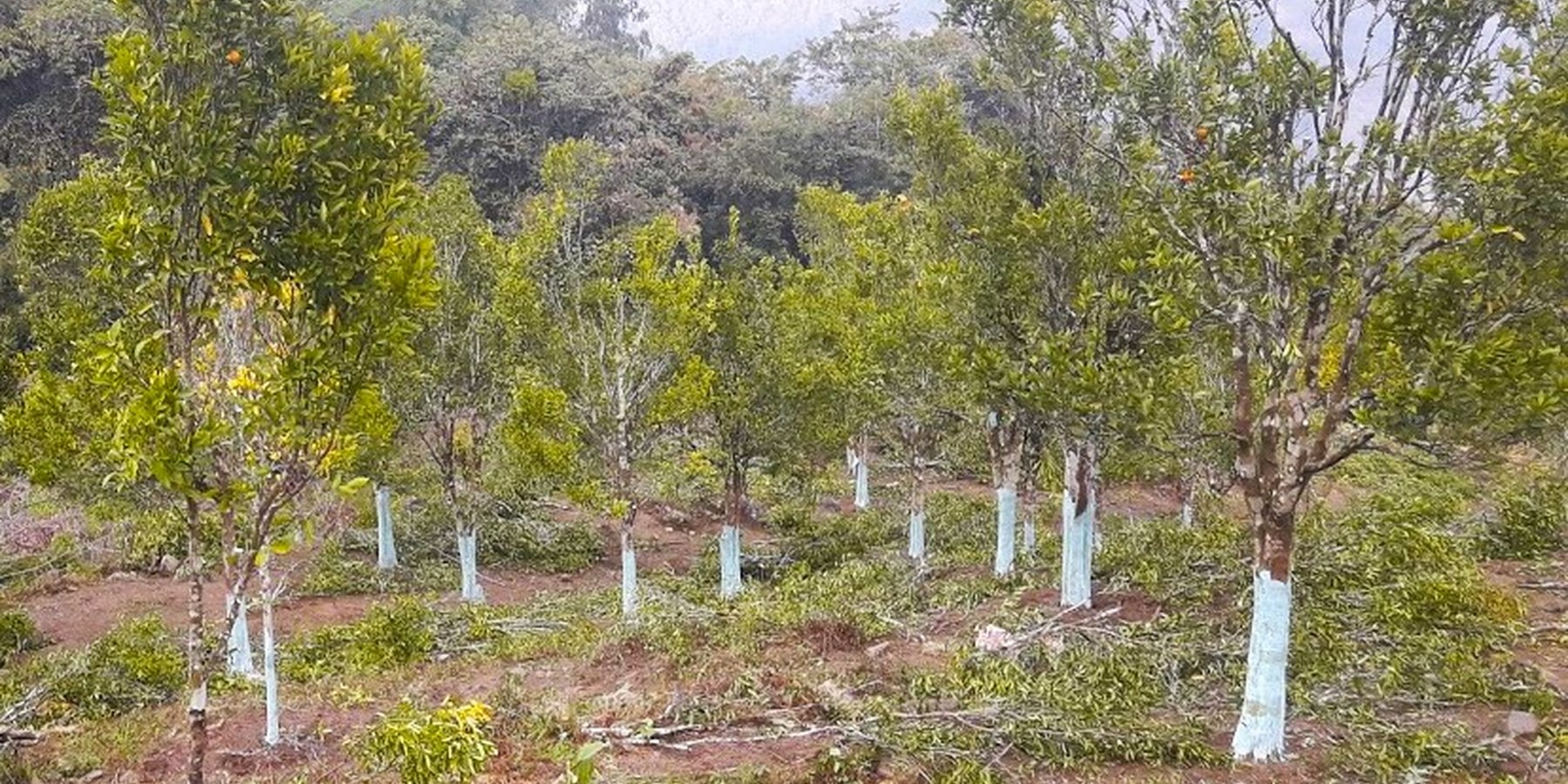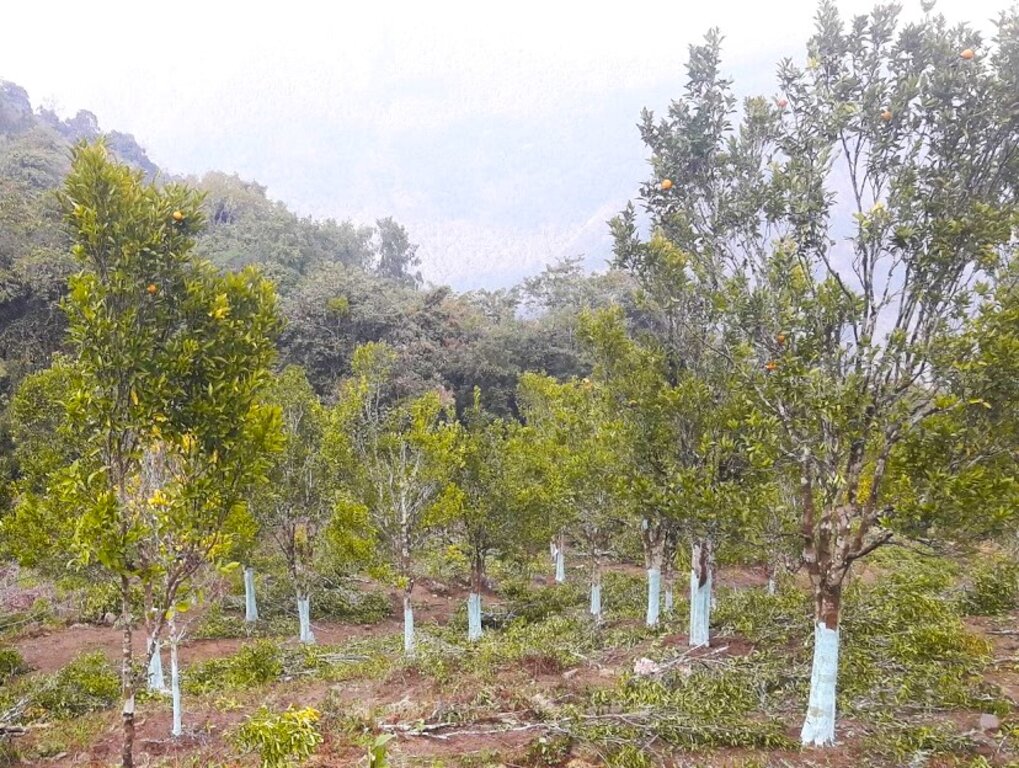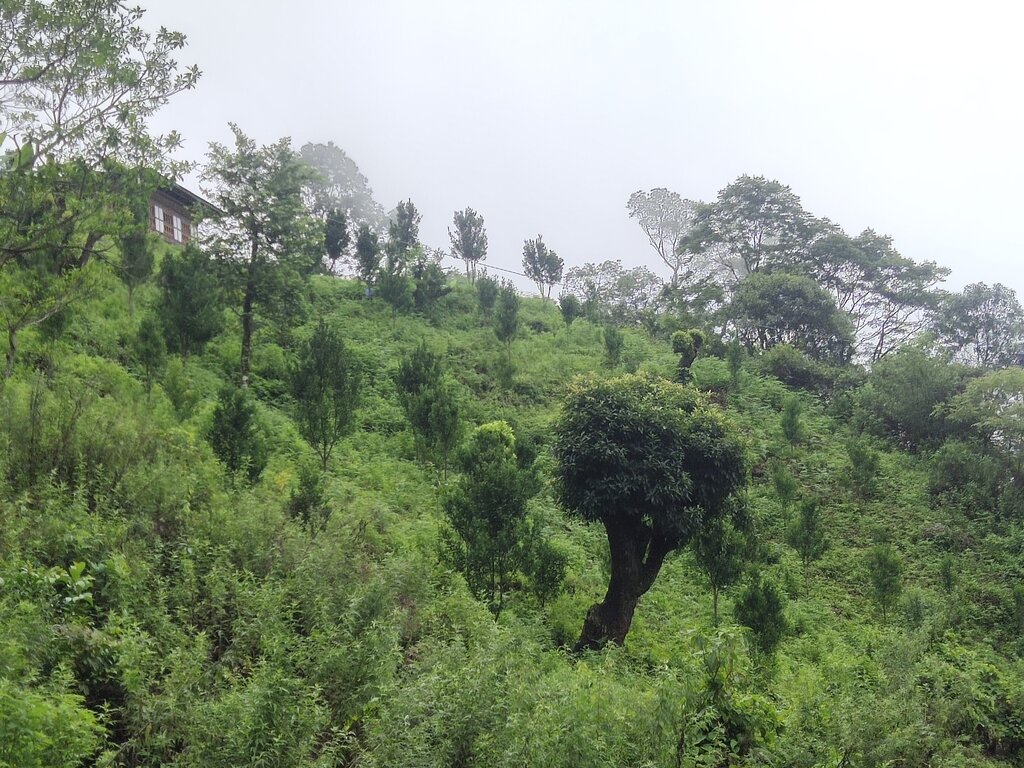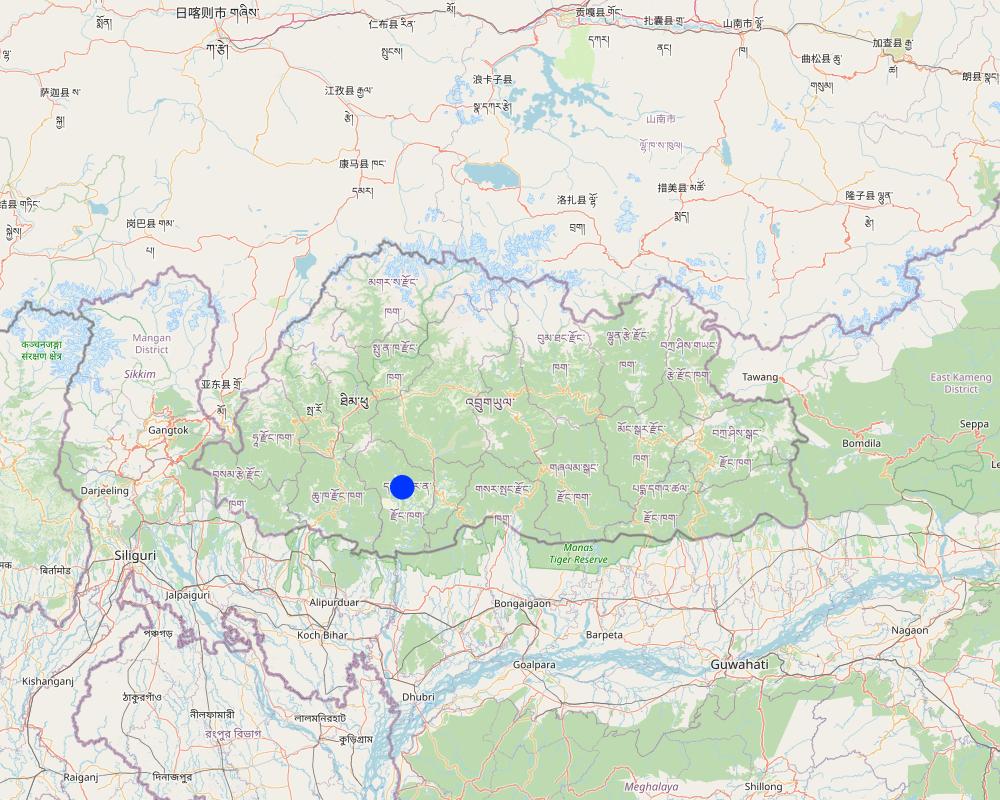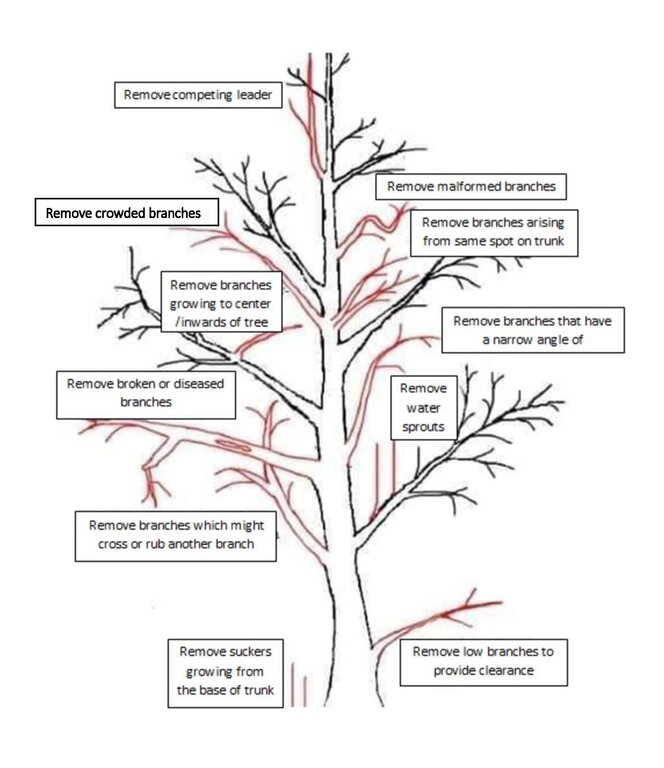Citrus Canopy Management and Rehabilitation Program [不丹]
- 创建:
- 更新:
- 编制者: Nima Dolma Tamang
- 编辑者: Kuenzang Nima
- 审查者: William Critchley, Rima Mekdaschi Studer
technologies_6847 - 不丹
查看章节
全部展开 全部收起1. 一般信息
1.2 参与该技术评估和文件编制的资源人员和机构的联系方式
关键资源人
土地使用者:
Lethro
不丹
有助于对技术进行记录/评估的项目名称(如相关)
Strengthening national-level institutional and professional capacities of country Parties towards enhanced UNCCD monitoring and reporting – GEF 7 EA Umbrella II (GEF 7 UNCCD Enabling Activities_Umbrella II)有助于对技术进行记录/评估的机构名称(如相关)
National Soil Services Centre, Department of Agriculture, Ministry of Agriculture & Livestock (NSSC) - 不丹1.3 关于使用通过WOCAT记录的数据的条件
编制者和关键资源人员接受有关使用通过WOCAT记录数据的条件。:
是
1.4 所述技术的可持续性声明
这里所描述的技术在土地退化方面是否存在问题,导致无法被认为是一种可持续的土地管理技术?:
否
2. SLM技术的说明
2.1 技术简介
技术定义:
Citrus canopy management refers to the set of practices and techniques employed to optimize the growth, health, and productivity of citrus trees by manipulating the structure and density of their canopy. Effective canopy management is crucial for achieving desirable outcomes in citrus cultivation, such as improved fruit quality, increased yields, efficient use of resources, and enhanced tree health.
2.2 技术的详细说明
说明:
Citrus canopy management practices remain basic in Bhutan. Thus, the Australian Centre for International Agricultural Research (ACIAR) project was initiated and demonstrated citrus canopy management practices in selected orchards in 2010. In the same year, the Japan International Cooperation Agency (JICA) project trained land users and extension officers in eastern Bhutan on citrus management practices such as planting methods, nutrient management, pruning and training including top working, fruit thinning and post-harvest management practices. Since then, citrus growers have been slowly adopting the practices in their orchards. However, the adoption rate is low - affecting the yield and quality.
Bhutan has suitable climatic conditions for citrus production, particularly in the southern parts of the country due to the subtropical climate. Citrus such as oranges, mandarins and lemons are grown in orchards and home gardens. In Bhutan, citrus canopy management practices focus on optimizing tree growth, fruit production, and overall tree health. The main elements include pruning, training systems, canopy density management, tree height and size control, and disease and pest management integrated with irrigation and nutrient management practices. Pruning involves selectively removing branches, shoots, or foliage to shape the tree and improve its health. The stump should always be cut as close to the collar region as possible. Training structures the tree in a specific manner to optimize growth and management. Canopy density management regulates foliage density for light penetration and airflow. Techniques such as hedging or topping control the height and size of trees. Disease and pest management practices include adequate air circulation and sunlight exposure. Integration with irrigation and soil nutrient management enhances tree health and productivity. The desirable shape and size of citrus are variable depending on the grower's choice, location, and - most importantly - operational health and safety concerns. In general, the desirable shape and size of the tree should be 2 to 5 m tall, 2 to 5 m width of canopy, and 4 to 6 primary (scaffold) branches that are at least 1 m above the ground level.
The purposes/functions of citrus canopy management technology are to optimize fruit production, improve tree health, and facilitate harvest and maintenance operations. It helps maximize fruit yield and quality. Pruning and maintenance practices enhance tree vigour, reduce the risk of diseases and pests, and improve overall plant health. Controlling tree size and shape makes harvesting easier and more efficient, and simplifies other maintenance activities such as irrigation, fertilization, and pest control.
To establish and maintain citrus canopy management technology, activities such as regular pruning and training, knowledge and skill development, use of proper tools and equipment, monitoring and assessment, irrigation, and nutrition management are required. Regular pruning and training of citrus trees according to the selected system and management objectives is essential. Monitoring tree growth, health, and productivity is important, along with proper irrigation scheduling, water management, and nutrient application.
The benefits/impacts of the technology are improved sunlight exposure, enhanced air circulation, reduced disease incidence, increased fruit size and quality, ease of harvest, consistent yield, optimized water use, better pest management, and others. A well-managed canopy makes it easier to access the fruit during harvest, and achieve higher yields and better-quality fruits, reduced need for pesticides, as well as directing nutrients toward fruit production rather than excessive vegetative growth. However, there are some drawbacks of the technology such as the requirement for time-consuming manual labour, lower initial yields, high initial investments for equipment, and concerns about over-pruning.
2.3 技术照片
2.5 已应用该技术的、本评估所涵盖的国家/地区/地点
国家:
不丹
区域/州/省:
Dagana Dzongkhag
有关地点的进一步说明:
Nindukha Village, Kana Gewog
具体说明该技术的分布:
- 均匀地分布在一个区域
如果不知道精确的区域,请注明大致覆盖的区域:
- < 0.1 平方千米(10 公顷)
技术现场是否位于永久保护区?:
否
Map
×2.6 实施日期
注明实施年份:
2019
2.7 技术介绍
详细说明该技术是如何引入的:
- 通过项目/外部干预
3. SLM技术的分类
3.1 该技术的主要目的
- 改良生产
- 适应气候变化/极端天气及其影响
- 创造有益的经济影响
3.2 应用该技术的当前土地利用类型
同一土地单元内混合使用的土地::
否

农田
- 乔木与灌木的种植
乔木和灌木种植 - 指定作物:
- 柑橘属
每年的生长季节数:
- 1
采用间作制度了吗?:
否
采用轮作制度了吗?:
否
3.3 由于技术的实施,土地使用是否发生了变化?
由于技术的实施,土地使用是否发生了变化?:
- 否(继续问题3.4)
3.4 供水
该技术所应用土地的供水:
- 混合雨水灌溉
3.5 该技术所属的SLM组
- 土壤肥力综合管理
- 灌溉管理(包括供水、排水)
- Tree canopy management
3.6 包含该技术的可持续土地管理措施

植物措施
- V5:其它

其它措施
具体说明:
Improve/optimize fruit production and quality by manipulating the growth and structure of trees.
3.7 该技术强调的主要土地退化类型

生物性退化
- Bc:植被覆盖的减少
注释:
Citrus canopy management increases productivity and reduces its susceptibility to diseases which ensures vegetation cover as the trees are not removed.
3.8 防止、减少或恢复土地退化
具体数量名该技术与土地退化有关的目标:
- 防止土地退化
- 减少土地退化
4. 技术规范、实施活动、投入和成本
4.1 该技术的技术图纸
技术规范(与技术图纸相关):
The spacing between trees is 6 m. There are a total of 100 trees per acre. Diseased or damaged trees are removed.
作者:
Thinley Penjor Dorji
日期:
22/08/2023
4.2 有关投入和成本计算的一般信息
具体说明成本和投入是如何计算的:
- 每个技术区域
注明尺寸和面积单位:
2.47 acre
如果使用本地面积单位,注明转换系数为1公顷(例如1公顷=2.47英亩):1公顷=:
1
其它/国家货币(具体说明):
Ngultrum (Nu.)
如相关,注明美元与当地货币的汇率(例如1美元=79.9巴西雷亚尔):1美元=:
80.0
注明雇用劳工的每日平均工资成本:
500
4.3 技术建立活动
| 活动 | 时间(季度) | |
|---|---|---|
| 1. | Pruning | Right after harvest |
| 2. | Applying Bordeaux mixture | Anytime |
| 3. | Making basin | Winter |
| 4. | Applying manure | Anytime |
| 5. | Removal of dead woods or shoots | Anytime |
4.4 技术建立所需要的费用和投入
| 对投入进行具体说明 | 单位 | 数量 | 单位成本 | 每项投入的总成本 | 土地使用者承担的成本% | |
|---|---|---|---|---|---|---|
| 劳动力 | Pruning | Person/day | 17.0 | 500.0 | 8500.0 | 100.0 |
| 设备 | Pruning saw | Number | 1.0 | 2000.0 | 2000.0 | 100.0 |
| 设备 | Secateurs | Number | 1.0 | 2500.0 | 2500.0 | 100.0 |
| 植物材料 | Sapling | Number | 247.0 | 150.0 | 37050.0 | |
| 肥料和杀菌剂 | Bordeaux mixture | Litres | 12.0 | 125.0 | 1500.0 | |
| 技术建立所需总成本 | 51550.0 | |||||
| 技术建立总成本,美元 | 644.38 | |||||
如果土地使用者负担的费用少于100%,请注明由谁负担其余费用:
The cost for sapling and biocide is borne by the Royal Government of Bhutan.
注释:
The total establishment cost of the technology for one hectare is USD 644.38. The Land users paid 100% of the equipment's cost. They follow a labour-sharing system whereby the labour employed in the farm is compensated by working in their fields and there is no cost involved.
4.5 维护/经常性活动
| 活动 | 时间/频率 | |
|---|---|---|
| 1. | Pruning of dead woods and water shoots | Anytime |
| 2. | Fertilizer application | Anytime |
| 3. | Shoot selection in the following years | Every year when new shoots sprout |
4.6 维护/经常性活动所需要的费用和投入(每年)
| 对投入进行具体说明 | 单位 | 数量 | 单位成本 | 每项投入的总成本 | 土地使用者承担的成本% | |
|---|---|---|---|---|---|---|
| 劳动力 | Pruning | Person/day | 7.0 | 500.0 | 3500.0 | 98.0 |
| 技术维护所需总成本 | 3500.0 | |||||
| 技术维护总成本,美元 | 43.75 | |||||
注释:
Only labour input is needed for maintenance/recurrent activities but the cost is zero as land users follow labour-sharing system.
4.7 影响成本的最重要因素
描述影响成本的最决定性因素:
The land users mentioned that the equipment is the main factor affecting cost.
5. 自然和人文环境
5.1 气候
年降雨量
- < 250毫米
- 251-500毫米
- 501-750毫米
- 751-1,000毫米
- 1,001-1,500毫米
- 1,501-2,000毫米
- 2,001-3,000毫米
- 3,001-4,000毫米
- > 4,000毫米
农业气候带
- 潮湿的
The area falls under the humid Subtropical zone from the six Agro-ecological zones of Bhutan.
5.2 地形
平均坡度:
- 水平(0-2%)
- 缓降(3-5%)
- 平缓(6-10%)
- 滚坡(11-15%)
- 崎岖(16-30%)
- 陡峭(31-60%)
- 非常陡峭(>60%)
地形:
- 高原/平原
- 山脊
- 山坡
- 山地斜坡
- 麓坡
- 谷底
垂直分布带:
- 0-100 m a.s.l.
- 101-500 m a.s.l.
- 501-1,000 m a.s.l.
- 1,001-1,500 m a.s.l.
- 1,501-2,000 m a.s.l.
- 2,001-2,500 m a.s.l.
- 2,501-3,000 m a.s.l.
- 3,001-4,000 m a.s.l.
- > 4,000 m a.s.l.
说明该技术是否专门应用于:
- 不相关
5.3 土壤
平均土层深度:
- 非常浅(0-20厘米)
- 浅(21-50厘米)
- 中等深度(51-80厘米)
- 深(81-120厘米)
- 非常深(> 120厘米)
土壤质地(表土):
- 粗粒/轻(砂质)
土壤质地(地表以下> 20厘米):
- 粗粒/轻(砂质)
表土有机质:
- 高(>3%)
如有可能,附上完整的土壤描述或具体说明可用的信息,例如土壤类型、土壤酸碱度、阳离子交换能力、氮、盐度等。:
Moisture content 2.88%, organic matter 6.17%, Organic carbon 3.59%, pH 6.23, electrical conductivity 178.27 µs/cm, nitrogen 0.18%, phosphorus 0.57 ppm, Potassium 134.73 mg/100ml, texture sand clay loam.
The soil analysis was conducted at the Science Laboratory of College of Natural Resources, Royal University of Bhutan, Lobesa, Punakha.
5.4 水资源可用性和质量
地表水的可用性:
好
水质(未处理):
良好饮用水
水质请参考::
地表水
水的盐度有问题吗?:
否
该区域正在发生洪水吗?:
否
5.5 生物多样性
物种多样性:
- 中等
栖息地多样性:
- 中等
关于生物多样性的注释和进一步规范:
The species and habitat diversity provided above are for the citrus orchard.
5.6 应用该技术的土地使用者的特征
定栖或游牧:
- 定栖的
生产系统的市场定位:
- 混合(生计/商业)
非农收入:
- 低于全部收入的10%
相对财富水平:
- 平均水平
个人或集体:
- 个人/家庭
机械化水平:
- 手工作业
性别:
- 男人
土地使用者的年龄:
- 中年人
5.7 应用该技术的土地使用者使用的平均土地面积
- < 0.5 公顷
- 0.5-1 公顷
- 1-2 公顷
- 2-5公顷
- 5-15公顷
- 15-50公顷
- 50-100公顷
- 100-500公顷
- 500-1,000公顷
- 1,000-10,000公顷
- > 10,000公顷
这被认为是小规模、中规模还是大规模的(参照当地实际情况)?:
- 小规模的
注释:
The orchard was of 1.3 acres or 0.52 hectares. The average land holding of Bhutan is 3.4 acres. Land users owning less than 3.4 acres are categorized as small-scale.
5.8 土地所有权、土地使用权和水使用权
土地所有权:
- 个人,有命名
土地使用权:
- 个人
用水权:
- 社区(有组织)
土地使用权是否基于传统的法律制度?:
是
具体说明:
The land use rights in Bhutan is traditional legal system guided by formal land act and land rules and regulations.
5.9 进入服务和基础设施的通道
健康:
- 贫瘠
- 适度的
- 好
教育:
- 贫瘠
- 适度的
- 好
技术援助:
- 贫瘠
- 适度的
- 好
就业(例如非农):
- 贫瘠
- 适度的
- 好
市场:
- 贫瘠
- 适度的
- 好
能源:
- 贫瘠
- 适度的
- 好
道路和交通:
- 贫瘠
- 适度的
- 好
饮用水和卫生设施:
- 贫瘠
- 适度的
- 好
金融服务:
- 贫瘠
- 适度的
- 好
6. 影响和结论性说明
6.1 该技术的现场影响
社会经济效应
生产
作物生产
注释/具体说明:
Land users mentioned that there was a significant increase in crop yield after canopy management.
作物质量
SLM之前的数量:
50-60%
SLM之后的数量:
80%
注释/具体说明:
The land users stated that the size of the fruit was bigger and of better quality after canopy management.
生产故障风险
注释/具体说明:
The land users stated that the risk of producing lower quality fruits that are not acceptable in the market has greatly reduced.
收入和成本
农业投入费用
注释/具体说明:
The cost of equipment is moderately expensive. However, the land users feel the cost is compensated by the increase in income. The land users also take special care of the equipment.
农业收入
注释/具体说明:
Improved quality and quantity of citrus are directly related to increased farm income as there is a higher price provided for good quality produce.
工作量
SLM之前的数量:
40%
SLM之后的数量:
50%
注释/具体说明:
The management practices such as training, pruning, and application of Bordeaux mixture are laborious. Therefore, the workload of land users has increased by about 10 per cent.
社会文化影响
食品安全/自给自足
注释/具体说明:
The land users are self-sufficient in terms of citrus. Further, the portion of their yield is shared with their relatives making the community self-sufficient. The income generated from selling the produce is used to procure nutritious foods from the market making them food secure.
健康状况
注释/具体说明:
Improved income if used efficiently increases the health situation of the family members.
SLM/土地退化知识
注释/具体说明:
The traditional practice did not include nutrient management of the orchard. The citrus canopy management technology includes proper manuring or nutrient management of the orchard leading to increased knowledge of SLM for the land users.
生态影响
生物多样性:植被、动物
植被覆盖
注释/具体说明:
The technology improved tree health reducing the risk of orchards converting to fallow land and increasing vegetation cover.
有益物种
注释/具体说明:
The improved soil and canopy management increased earthworm and bee populations on the farm.
害虫/疾病控制
注释/具体说明:
After canopy management, the land users stated that they have experienced fewer pest and disease incidences. This could be due to better sunlight penetration and air movement in the tree canopy.
6.2 该技术的场外影响已经显现
对邻近农田的破坏
注释/具体说明:
The orchard harbouring pests and diseases can damage neighbouring fields as the diseases are transmitted from one field to another through vectors and other sources. Therefore, the technology improves the health of the orchard and prevents the risk of damaging neighbouring orchards.
6.3 技术对渐变气候以及与气候相关的极端情况/灾害的暴露和敏感性(土地使用者认为的极端情况/灾害)
渐变气候
渐变气候
| 季节 | 增加或减少 | 该技术是如何应对的? | |
|---|---|---|---|
| 年温度 | 增加 | 好 | |
| 年降雨量 | 减少 | 好 |
气候有关的极端情况(灾害)
气象灾害
| 该技术是如何应对的? | |
|---|---|
| 局地雹灾 | 不好 |
生物灾害
| 该技术是如何应对的? | |
|---|---|
| 流行病 | 不好 |
| 昆虫/蠕虫侵扰 | 不好 |
6.4 成本效益分析
技术收益与技术建立成本相比如何(从土地使用者的角度看)?
短期回报:
轻度消极
长期回报:
非常积极
技术收益与技术维护成本/经常性成本相比如何(从土地使用者的角度看)?
短期回报:
积极
长期回报:
积极
6.5 技术采用
- 11-50%
如若可行,进行量化(住户数量和/或覆盖面积):
7 households adopted the technology from the total of 50 households.
在所有采用这项技术的人当中,有多少人是自发的,即未获得任何物质奖励/付款?:
- 0-10%
注释:
All the farmers received material incentives from the government.
6.6 适应
最近是否对该技术进行了修改以适应不断变化的条件?:
否
6.7 该技术的优点/长处/机会
| 土地使用者眼中的长处/优势/机会 |
|---|
| Increased production. The canopy management technology increases production in the long run although there is a sudden reduction in the yield in the first year of implementation. |
| Improved quality. The technology is a wholesome approach to improving the canopy, nutrient management and irrigation management leading to quality fruit production. |
| Reduced pests and disease incidence. The technology reduces the favourable environment for the multiplication of diseases and pest. For example, by pruning the canopy which increases aeration ultimately reducing fungal growth. |
| 编制者或其他关键资源人员认为的长处/优势/机会 |
|---|
| Increased income and improved livelihood. Canopy management increases yield in the long run leading to increased farm income and improved living standards of the land users. |
6.8 技术的弱点/缺点/风险及其克服方法
| 土地使用者认为的弱点/缺点/风险 | 如何克服它们? |
|---|---|
| Labour intensive. The technology includes pruning, thinning, irrigation and nutrient management activities which require a lot of labour. | Implementing a labour-sharing mechanism as it is cost-effective and strengthens community collaboration. |
| 编制者或其他关键资源人员认为的弱点/缺点/风险 | 如何克服它们? |
|---|---|
| Low initial crop yield. Due to excessive pruning in the first year of technology implementation, there is a marked reduction in the yield of the citrus. | With better care and management, yields increase after 2 to 3 years. |
7. 参考和链接
7.1 信息的方法/来源
- 实地考察、实地调查
One
- 与土地使用者的访谈
One
(现场)数据是什么时候汇编的?:
15/07/2023
7.3 链接到网络上的相关信息
标题/说明:
Canopy Management Guide for Citrus Mandarin in Bhutan
URL:
http://rcbajo.gov.bt/wp-content/uploads/2020/05/Canopy-management-guide-for-citrus-mandarin.pdf
标题/说明:
Pruning and Training - Evergreen Trees
URL:
http://rcbajo.gov.bt/wp-content/uploads/2020/06/Pruning-Training-evergreen.pdf
链接和模块
全部展开 全部收起链接
无链接
模块
无模块


